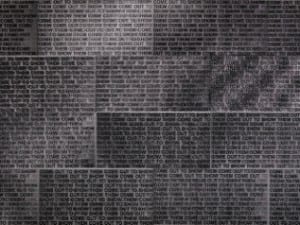Cornelia Parker (b. 1956) is a British sculptor and installation artist who is interested in the potential of materials. Her latest involvement is with Glasstress: White Light / White Heat, as one of 65 artists challenged to work with glass. The show runs at two different locations in London: London College of Fashion’s Fashion Space Gallery (until 23 February) and The Wallace Collection (until 26 February). www.glasstress.org.
What made you want to participate in this particular project? Was it an interest in the material that drew you to it?
Yes. The material is often where my thinking starts. I’ve used glass on a few occasions: for example, I did a piece called One Day This Glass Will Break (1995), which is a stack of glasses with a one-word engraving on each. I don’t really make things from scratch; I’d rather destroy something. The premonition that this fragile material will break is the inspiration behind my piece for Glasstress: a glass drum I call Decoy, as it lures people in to want to beat the drum, whereupon it will shatter. The drumroll will be falling glass.
Why does your work often include fragmented structures, such as in Thirty Pieces of Silver (1988-9)?
I prefer things when they’re fractured for some reason. I’ve always responded to fragmented things: if something’s squashed in the road, I’m drawn to it. A squashed object is much more interesting than an intact one and I think brokenness is very much a part of society. Civilisations fall, for instance, or a very recognisable object can become mysterious and more open to interpretation when it’s in pieces. To me, that’s more interesting than what is whole. I have also been inspired by other artists who deal with the fragment and things that are immaterial, such as Marcel Duchamp and Tony Cragg.
Are there particular objects that you find yourself drawn to, apart from those that are crushed?
I use a lot of clichéd objects: a pearl necklace, a silver spoon, a hat for church, a window or the instruments from a brass band – things that are kind of commonplace and that are so ubiquitous everyone understands what they are. I take very simple things and use them to achieve the abstract. I find that recognisable things and found objects are a way into the surreal.
You’ve worked with the actress Tilda Swinton on her piece, The Maybe (1995). Are you interested in performance art?
That came out of a collaboration. Tilda had the idea of sleep in space and Snow White in a glass coffin and we decided to get together. I created an installation where she slept as herself surrounded by found objects purporting to have belonged to well-known historical figures. It was a great partnership based on something that was different from our previous experience.
When you are producing work are you overly concerned about what the audience’s response will be?
It’s hard not to be. Usually the things I make are those that keep pushing away at my subconscious wanting to be made and I just hope that people respond to them. I like using the found object because people don’t have to worry about what it is. There’s mystery there but it frees the viewer to be able to project onto it. I’ve had a great reaction from the general public: it’s almost as though they’ve been given permission to enter the work.
Do you find that the personal informs your practice?
Yes, of course, but it is also influenced by universal concerns. Death is something that affects everyone and this appears in This Glass Will Break. The work reflects a psychological state that is comparable to mortality; we all know that it will come to an end one way or another; it’s just a question of time. However, my work is often based on a neurotic fear of mine that I need to get out of my system, although I don’t want my baggage to weigh it down.
When you construct your installations, do you have an idea of the space in which they will be presented before you make them?
With a large-scale piece, I will make it fit the original space but I don’t mind expanding or contracting it to suit other venues, as necessary. However, it’s not only the physical dimension that can change, it’s also the psychological space it occupies, depending on the audience. Cold Dark Matter: An Exploded View (1991) was an exploded shed on display at the Tate and a lot of people in war-torn countries saw that elsewhere and responded to it; they had a very different history to the people who saw it in London. In Ljubljana, I showed a piece about a house that fell off the White Cliffs of Dover (Neither From Nor Towards (1992). The refugees from Sarajevo who saw it thought of it as a political statement, which reflected what they were going through.





